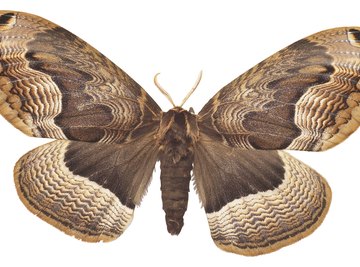
There are many different types of moths among the more than 160,000 species worldwide. A lot of moths are nocturnal, meaning they are active at night. However, diurnal moths are active during the day and crepuscular moths are most active during dawn and dusk. Moth mating usually involves simple insect courtship behavioral patterns. Moth larvae look different from adults. This is called a complete metamorphosis development lifecycle.
Types of Moths
Moths and butterflies are in the order Lepidoptera. Many countries have their own endemic moths, which means these types of moths are found nowhere else in the world. For example, New Zealand has more than 2,000 species of lepidopterans – all except 17 are moths and over 90% are endemic.
While typical moth colorations are dull browns or greys, there are many species of colorful moths, such as the bright lime green luna moth (Actias luna). Moths are classified into families based on their morphology. Four of the larger and more distinct families are called Noctuidae, Geometridae, Arctiidae and Saturniidae. Informally, tiny moths like the codling moth (Cydia pomonella) are given the term Microlepidoptera.
Noctuidae is the largest family with some 25,000 species worldwide, including larvae called cutworms, fruit worms and underwing moths. Geometridae includes around 15,000 species. Due to their movement patterns, the larvae in this family are called inchworms.
Arctiidae includes around 10,000 species worldwide, including many brightly colored red and yellow moths. Saturniidae is a family of large moth species which includes the Hercules moth (Coscinocera hercules) of Australia, whose female has the largest wingspan in the world at 10.6 inches.
Moth Antennae
The easiest way to tell a moth apart from a butterfly is by looking at its antennae. Butterflies have thin antennae with a bulbous knob on the end. Male moths have large, feathery-looking antennae. Female moths have thinner antennae, more like butterflies, except they lack the bulbous knob at the end.
Moths Mating
Classic moth mating behavior sees the female waiting on a perch after emerging from her cocoon and releasing chemical signals called pheromones to lure in male moths. The male moths fly around, seeking the pheromones released by a female. When he finds her, they will face away from each other to join abdomens, where their genitalia are located, then he will transfer sperm to her for fertilization.
Once mated, the female searches for a place to lay her eggs that has plenty of the right food for the larvae. The moth eggs then hatch into a larval form. The larvae eat continuously and grow through several stages, called instars, before becoming a pupa then metamorphosizing into an adult moth. The next generation adults repeat the mating process, completing the moths' life cycle.
Instead of pheromones, acoustic signaling moths use ultrasonic sounds to attract mates. In these species, it is often the male that emits sounds to attract the female. For example, the male Asian corn borer (Ostrinia furnacalis) uses his ultrasonic song to attract receptive females. His song causes the females to 'freeze,' increasing mating success.
Gold Swift Moth
The gold swift moth (Phymatopus hecta) of Northern Europe and Asia has an extremely elaborate mating system with more than seven different courtship strategies. Unusually, both the male and female emit pheromones to attract each other. The males also sometimes form groups, called leks. In the leks, they flutter and perch together, displaying their wings and bright yellow scent brushes (a cluster of hairs on their legs containing pineapple-scented pheromones). Females come to view the lek, then pick their favorite from the group to mate with.
Depending on who sees who first, the female can also use her pheromones to lure in a mate. Sometimes the male and female perform a courtship dance where they both hover together before landing to mate. They also have a variety of mating positions they use to help avoid predatory bats. They can mate face-to-face, with their abdomens' tips touching, or back-to-front, where the male faces away from the female.
References
About the Author
Adrianne Elizabeth is a freelance writer and editor. She has a Bachelor of Science in Ecology and Biodiversity, and Marine Biology from Victoria University of Wellington in New Zealand. Driven by her love and fascination with all animals behavior and care, she also gained a Certificate in Captive Wild Animal Management from UNITEC in Auckland, New Zealand, with work experience at Wellington Zoo. Before becoming a freelance writer, Adrianne worked for many years as a Marine Aquaculture Research Technician with Plant & Food Research in New Zealand. Now Adrianne's freelance writing career focuses on helping people achieve happier, healthier lives by using scientifically proven health and wellness techniques. Adrianne is also focused on helping people better understand ecosystem functions, their importance, and how we can each help to look after them.
Photo Credits
Hemera Technologies/PhotoObjects.net/Getty Images
